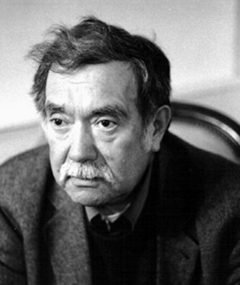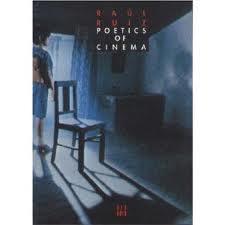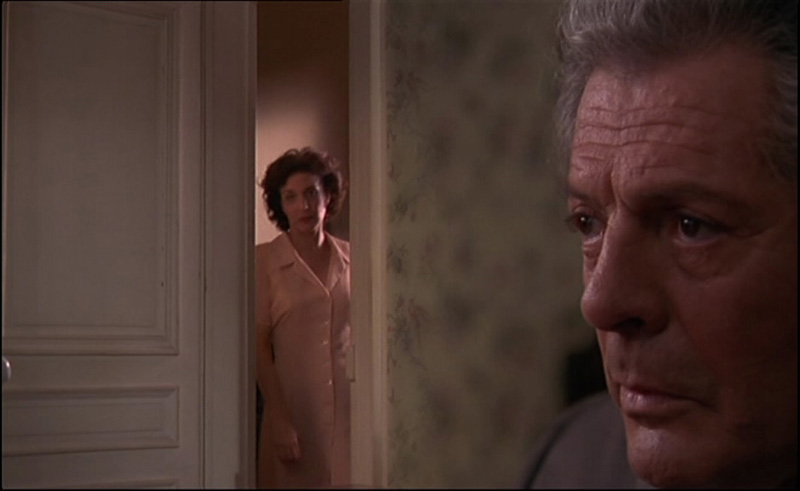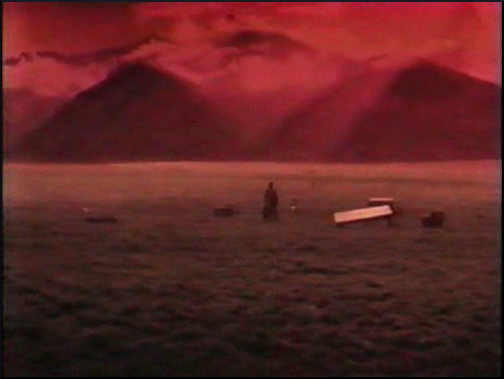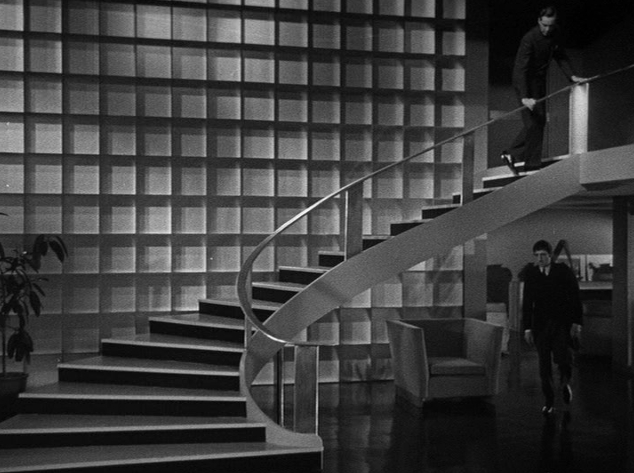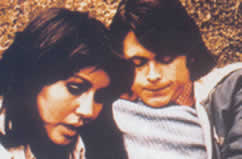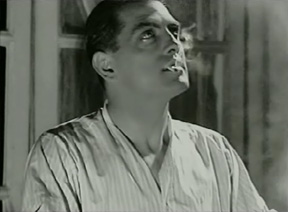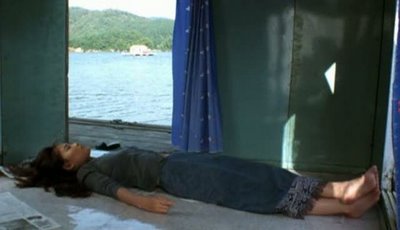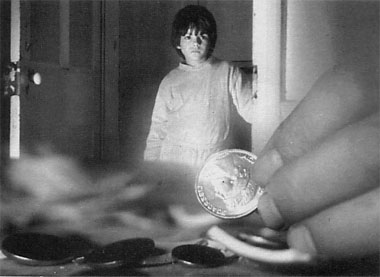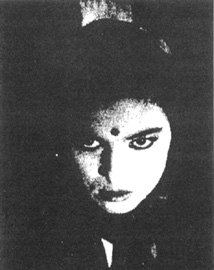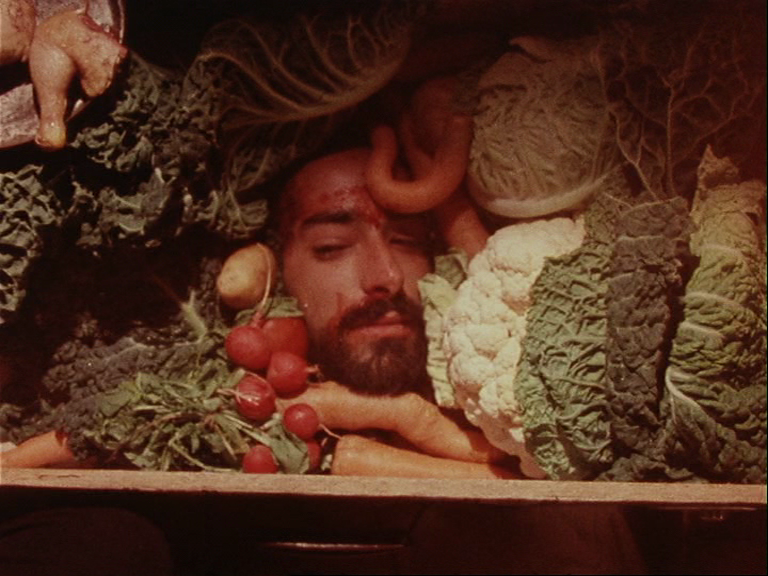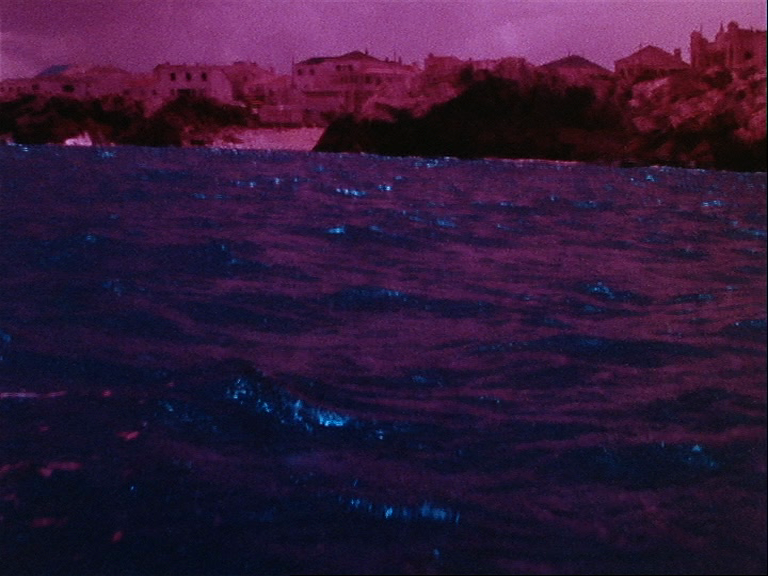What dispiriting news, to learn of Raúl Ruiz’s death at age 70 upon waking today [in August 2011], just after receiving the Portuguese DVD box set of his extraordinary Mysteries of Lisbon yesterday and watching the first half of it last night. I knew, of course, that his health had been very poor, so this wasn’t entirely a shock. But it’s clearly a major loss. (A curious coincidence: Raúl lived the same number of years as the filmmaker he admired the most, Orson Welles.)
We had been friends for a time, then drew apart — mainly, I suspect, because he became a little fed up with my inability to speak and understand French more fluently. But I’m very grateful for the many hours we were able to spend together, including one opportunity I had to appreciate what an excellent cook he was. (For an excellent memoir about him, as well as one of the best appreciations of Ruiz that I know — even though I disagree with its premise that Klimt qualifies as a biopic [at least in its original, longer, and better version], and Raúl himself disagreed with the premise that Three Lives and Only One Death was one of his best films — check out Adrian Martin’s “A Ghost at Noon” at http://www.filmcritic.com.au/essays/ruiz.html.)
An annotated, critical Ruiz filmography through early 2005 can be found here. And just below, reposted, is the second of my two long essays about him (not counting my long Chicago Reader reviews of some of his individual features), which is well over a decade out of date but helps to explain some of the reasons why I value him so highly. It originally appeared in the January-February 1997 issue of Film Comment. My earlier long piece about Ruiz is available here, and my lengthy 2002 interview with him, newly illustrated, can be found at this link. — J.R.
1. Ruiz’s Secret (Iowa City)
On a bet, and with the help of a Rockefeller grant, Raúl Ruiz — born in Puerto Montt, Chile, in 1941 — wrote one hundred plays between the ages of 17 and 20. Or maybe it was between the ages of 16 and 21; accounts differ. (”It was very easy,” he told one interviewer; “they were not really plays. Some of them were five pages long, others were one hundred pages, but most were very short plays.”)
Many years later, after he became a filmmaker, he decided to make one hundred films by the time was 50. How close he’s come to achieving that aim is debatable, depending on how you keep count: does a serial or a miniseries count as one film or several? And what about videos? But the latest tally of works includes 90-odd titles, all of them written or cowritten as well as directed by Ruiz. Anyway, Ruiz more recently claims to have reconfigured his ambition; now it’s to make more films than all other Chileans combined. More like a termite than like a white elephant (to adopt Manny Farber’s suggestive terms), he still wants to forge a legend — and he has.
How has he managed to do so much? A number of interlocking factors come into play. For one thing, the hundred plays he wrote in his youth provided him with a lot of material to recycle. For another, at some point after moving from Chile to Paris in 1974, five months after the military coup, he began to accept all sorts of state TV commissions (mainly French, but also German, English, Dutch, Portuguese, and eventually Italian); the idea was to refuse nothing, to keep on working — regarding filmmaking as an artisanal, everyday process. From an auteurist point of view, this creates several ambiguities — especially because many of Ruiz’s TV commissions, no matter how recognizable to his fans, are essentially anonymous works for most of their viewers.
Within my experience, Ruiz is the least neurotic of filmmakers; he doesn’t even seem to care whether what he’s doing is good or not (and, as he’s aptly noted, bad work and good work generally entail the same amount of effort). No single film functions as the be-all or end-all of an evolving career, but merely as part of an overall process. Example: the 1985 Régime sans pain – one of his films most influenced by his friend Jean Baudrillard, and perhaps the one that most calls to mind grade-Z SF — grew out of a commission to direct a music video. Ruiz offered a counterproposal that he direct several music videos rather than one; once this deal was made, he shot enough material to interconnect the various videos until he arrived at a feature.
A little later, while serving as the codirector of Le Havre’s Maison de la Culture, Ruiz wound up producing his own films and those of many others — meanwhile producing, directing, and/or writing plays and other theatrical events, writing novels, teaching, and creating museum installations. Over the past year, he’s shot a movie in Taiwan, directed Marcello Mastroianni in his most accessible feature to date (Three Lives and Only One Death, 1996), contemplated becoming a French citizen, directed Catherine Deneuve in another movie (Généalogies d’un crime, 1997), and taught filmmaking for the second time at Duke.
If you’re still wondering how he can accomplish so much — and be relaxed rather than frayed or frantic about it — an anecdote he told me a few years back may be more indicative of his secret than any other. During part of the period when he was writing his one hundred plays, he attended the University of Iowa’s famous writer’s workshop program. In a playwriting seminar, after arguing with a teacher who asserted that all drama is necessarily based on conflict, he went to see Kurt Vonnegut Jr., another teacher in the program, for advice; Vonnegut suggested he leave Iowa, and Ruiz did exactly that. (Soon afterwards, he had a stint writing melodramas in Mexico. Ruiz to Ethan Spigland in Persistence of Vision no. 8: “Mexican melodramas use the structure of 19th century European melodrama, in which the main character never conducts the action but, instead, is moved by the action. It’s a logic governed by miracles. In American soap operas and American stories in general, it is always a question of will.”)
Once you decide that drama isn’t based on conflict, a lot of unforeseeable things become possible, and the cinema of Raúl Ruiz is one of them. Look at the first chapter of his book Poetics of Cinema (Paris: Dis Voir, 1995), which spells out this argument in some detail, and even gives it some national, cultural, and political inflections:
America is the only place in the world where, very early, cinema developed an all-encompassing narrative and dramatic theory known as central conflict theory. Thirty or forty years ago, this theory was used by the mainstream American industry as a guideline. Now it is the law in the most important centers of film industry in the world.
What are the implications of this law? Skip ahead 13 pages to one of the chapter’s closing arguments:
The criteria according to which most of the characters in today’s movies behave are drawn from one particular culture (that of the USA). In this culture, it is not only indispensable to make decisions but also to act on them, immediately (not so in China or Iraq). The immediate consequences of most decisions in this culture is some kind of conflict (untrue in other cultures). Different ways of thinking deny the direct causal connection between a decision and the conflict which may result from it; they also deny that physical or verbal collision is the only possible form of conflict. Unfortunately, these other societies, which secretly maintain their traditional beliefs in these matters, have outwardly adopted Hollywood’s rhetorical behavior. So another consequence of the globalization of central conflict theory — a political one — is that, paradoxically, “the American way of life” has become a lure, a mask: unreal and exotic, it is the perfect illustration of the fallacy that Whitehead dubbed “misplaced concreteness.” Such synchronicity between the artistic theory and the political system of a dominant nation is rare in history; rarer still is its acceptance by most of the countries in the world. The reasons for this synchronicity have been abundantly discussed: politicians and actors have become interchangeable because they both use the same media, attempting to master the same logic of representation and practicing the same narrative logic–for which, let’s remember, the golden rule is that events do not need to be real but realistic. (Borges once remarked that Madame Bovary is realistic, but Hitler isn’t at all.) I heard a political commentator praise the Gulf War for being realistic, meaning plausible, while criticizing the war in former Yugoslavia as unrealistic, because irrational.
The metafictional universe of Ruiz is neither real nor realistic — only possible, or let’s say conceivable, because Ruiz thinks and films it. Whether this makes it good or bad, commercial or uncommercial, is another matter, existing off somewhere in a parallel universe — and fortunately not one that Ruiz has to worry about much, because unlike practitioners of central conflict theory, he doesn’t have to draw in large crowds in order to keep on working.
Does that make him crazy, or us?
2. In the Interests of Full Disclosure (Boston)
In 1990, when he was teaching at Harvard, presenting his first installation (”The Expulsion of the Moors”) at Boston’s Institute of Contemporary Art, and shooting his first American film (The Golden Boat), Ruiz was interviewed on Boston TV by critic David Sterritt, who asked him, “Do you have a particular audience in mind when you do your films?” “I think I’m quite friendly,” Ruiz replied. “I have a lot of friends, and these friends are from different countries and from different cultural and economic levels. My idea is to put all my friends together.” He added that he assumed that all his friends were duplicated by people of similar tastes and temperaments, “so maybe the model of my audience is those friends.”
For a little over a decade, I’ve been one of those friends — having met Ruiz at various times in Rotterdam, San Sebastian, Manhattan, Cambridge, Chicago, Washington, and, most frequently, Paris, his principal base of operations. I’ve seen about half his films and videos in many of the same places, as well as in Cannes, Locarno, London, Los Angeles, and Santa Barbara — in some cases without subtitles, in many cases with only partial comprehension. I’ve also been privileged to sample his superb cooking (specifically, a bouillabaisse prepared and served in discrete layers or “chapters” — a narrative form of cuisine evoked in more grotesque terms in the last episode of A TV Dante: Cantos 9-14, a 1992 series), and I once tried without success to snag him the commission of “completing” Orson Welles’ The Dreamers (a treasured late project derived from two Isak Dinesen stories that yielded about half an hour of Welles footage).
In other words, I qualify as a Ruizian, even if I like some Ruiz films much more than others. The last time we met, in Paris last June, was shortly after I saw Three Lives and Only One Death in Cannes, which struck me as being the best of his movies I’d seen in a long time, though I quickly discovered it wasn’t one of his own favorites (despite the fact that he fully acknowledged it as his own work). When I told him it reminded me of late Buñuel, he replied he didn’t regard that as a compliment — much preferring Buñuel’s Mexican films to his late, French works, and his own 1995 Fado majeur et mineur (which I hadn’t much liked — or understood, for that matter) to Three Lives and Only One Death. An earlier effort of mine to grapple with Ruiz (”Mapping the Territory of Raúl Ruiz,” 1990) can be found in my collection Placing Movies: The Practice of Film Criticism (University of California Press, 1995). What follows recasts a few of the same arguments, but generally the aim here is to correct, augment, and update many of my earlier remarks rather than duplicate them. Given that only four of Ruiz’s features are currently available in the U.S. on video — The Hypothesis of the Stolen Painting (1978), On Top of the Whale (1982), Life Is a Dream (1986), and The Golden Boat (1990) — perhaps it would be most useful if I started with these.
3. The Hypothesis of the Stolen Painting (Paris)
One of his first French TV commissions, and possibly the best of his black-and-white films. His assignment: to make an arts documentary on French writer and painter Pierre Klossowski — a novelist (one of whose novels, The Suspended Vocation, Ruiz had already adapted the year before), a commentator on the Marquis de Sade, a brother of the painter Balthus, and a painter of some distinction in his own right. What emerged isn’t really an art documentary, but it starts off by offering a deadly parody of one. Ruiz began by considering what TV documentaries were like in general: “I looked at television programs on famous personalities and observed that the usual format is a voiceover which poses questions. So I kept to this format and developed it into a kind of philosophical dialogue. This is the basic format, which is exactly the same as any banal television program on almost any subject.” As pointed out by critic Ian Christie –probably the individual most responsible for introducing Ruiz to the English-speaking world — Ruiz’s two principle strategies were “parody and literalism, both ‘rationalist’ in their pedigree and both calculated to subvert the normal discourse of television.” Knowing the importance of slick production values in France, Ruiz hired the superb Sacha Vierny, who shot all of Alain Resnais’ early features and has more recently worked for Peter Greenaway.
What’s subversive about Ruiz’s fulfillment of his assignment is that he essentially invented a series of fictitious paintings by a fictitious painter — invented, in turn, by Klossowski, who collaborated with Ruiz on the script — and got an actor to play a fictional art collector who has a dialogue with the offscreen narrator about the paintings. What comes out of this is not only parody, but also a mystery story, an essay about representation, and, as critic Thomas Elsaesser puts it, “a very literarv meditation on the subject of parallel worlds, of secret messages disguising themselves as accident and coincidence.”
4 & 5. La toit de la baleine/On Top of the Whale (Holland and Patagonia)
At some point in the future, a “communist millionaire” (Fernando Bordeu) from Patagonia invites an anthropological couple in Holland (Jean Badin and Willeke van Ammelrooy) to come visit him with their son and study his Indian neighbors, Eden and Adam (Ernie Navarro and Herbert Curiel), the last survivors of a lost tribe. Dressed in black suits, this odd pair confounds the couple’s efforts to penetrate their language (”Today’s rain hasn’t the same name as yesterday’s rain,” for instance), but meanwhile the anthropologists and their son go through a number of profound alterations; the little boy even undergoes a spontaneous sexual change after gazing into a mirror and becomes pregnant.
Shot by the peerless Henri Alekan (whom Ruiz almost singlehandedly brought out of retirement) in the Dutch countryside over twelve days, On Top of the Whale has a good many satirical points to make about culture, language, and representation. It unfolds in half a dozen different languages — one of them invented for Eden and Adam — and formal permutations are even more numerous than linguistic ones. Each shot in this playful, pokerfaced comedy becomes an event less in terms of plot than in terms of what Ruiz is doing with composition, color, perspective, camera placement, and visual texture. This is one of Ruiz’s best collaborations with Chilean composer Jorge Arriagada — as much a mainstay in his work as Bernard Herrmann was for a spell in Hitchcock’s — whose scores specialize in furnishing lush, atmospheric Hollywood climaxes, often without any apparent dramatic motivation.
6. Mémoire des apparences/Life Is a Dream (Le Havre) This was derived from Ruiz’s stage production of Calderón’s Spanish play Life Is a Dream, which utilized a new French translation of two Calderón texts by Jean-Louis Schefer, another Ruiz friend and sometime collaborator. Both texts have the same title, La Vida Es Sueño, but were written forty years apart, comprising respectively the “profane” and “sacred” version of the same story. Ruiz’s stage production used the “profane” version, as does the film, although the latter also manages to incorporate a few elements from the “sacred” version.
In Calderón’s original play, written in the 1630s, Segismundo, the son of the King of Poland, is imprisoned in a remote tower by his father after the latter’s horoscope predicts that his son will depose him. Later, the king orders that Segismundo, still asleep, be brought to the palace for a day, and when there, Segismundo does try to assume power. When he awakes back in his tower prison, he assumes he dreamt the palace episode. Segismundo’s curtain speech at the end of Act II, which has been compared to Hamlet’s “To be or not to be” soliloquy, concludes, in William E. Colford’s translation,
What is life? A Frenzy. What is life?
A shadow, an illusion, and a sham.
The greatest good is small; all life, it seems,
Is just a dream, and even dreams are dreams.
In the third act, buttressed with his conviction, Segismundo leads the Polish rebels to the palace. In the “auto sacramental” version of the play, written in the 1670s, the characters become allegorical abstractions such as Wisdom, Free Will, Man, Grace, and Love. According to Colford, “Segismundo’s triumph over himself is likened to the redemption of fallen man through the Sacraments of Baptism and Communion (Corpus Christi).”
In the movie — not so much an adaptation of the plays as a relocation of certain passages within a larger structure of Spanish baroque — these passages function in the story as a mnemonic device by which a member of the Chilean underground resistance memorizes the names and addresses of fellow resistance members and, ten years later, tries to summon them up at a provincial movie theater that is apparently showing a film of the Calderón play. But the snatches of the movie we see don’t come from a single source, comprising instead a whole smorgasbord of pop genres — space opera, film noir, swashbuckler, melodrama, even a bit of surrealist musical. This means that Segismundo’s famous curtain speech plays over an Arabian Nights fantasy and a Flash Gordon adventure, and the theater auditorium itself becomes a second dream world where birds fly overhead, chickens strut below, a model train runs by, an old-fashioned Hollywood shootout takes place among the seats, and a police station is uncannily located directly behind the movie screen.
7. The Golden Boat (New York)
In November 1987, at a panel discussion held in Manhattan, one member of the audience, noting Ruiz’s interest in wide-angle lenses and low and canted angles — comprising what many have called his Wellesian camera style — asked him if he’d ever contemplated shooting a film in 3-D. His deadpan answer was yes he had, and he’d even worked out a method: to paint all the actors and scenery red and green and distribute red and green 3-D glasses to viewers. “You could also do the same thing on the stage,” he added helpfully.
This sort of laidback alienation from narrative illusion — also reflected in his cherished project to film Hamlet with a cast of vegetables — leads to what might be regarded as both the boon and the curse of Ruiz’s work, central to what is both good and bad about The Golden Boat, his only made-in-America feature to date. Shot by the resourceful Maryse Alberti (Crumb) and scored by the eclectic John Zorn (another pal of Ruiz’s), it undermines its own premises so repeatedly and relentlessly in terms of settings, characters, and plot that it eventually becomes a kind of textbook illustration of the law of diminishing returns. (Even Three Lives and Only One Death, for all its relative charm and ease, skirts similar problems; as a French friend remarked, “If anything can happen in a film, nothing in it matters very much.”) Visiting Ruiz at Harvard between the two long weekends he spent shooting The Golden Boat in New York and environs, I recall he was unhappy about the size of the crew, many times the size of what he was comfortable with; it seemed every film student in lower Manhattan wanted to work on the film, and he characteristically found it difficult to say no.
The movie does convey some of Ruiz’s feelings about American violence, central conflict theory and all: the central figure is homeless serial killer named Austin (Michael Kirby) whose stabbings are so affectless that their main consequences are chiefly formal. (In the first murder we see, the knife thrust coincides with the first of the film’s many temporary shifts from color to black and white.) The young hero (Federico Muchnik) shifts blithely from being an artist and a Village Voice art critic a scene later, and his thesis adviser, initially played by writer Kathy Acker, is later transformed into Alina (Mary Hestand) — the first murder victim, resurrected without explanation. (A more systematic exploration of this principle can be found in La Professor Taranne, a 1987 adaptation of an Arthur Adamov play in which all eleven actors rotate their parts.) Physical space is equally mutable, and causal gags abound: when two characters repair to a diner, they each order a sushi dog and a wonton enchilada; and much of the dialogue pivots around absurdist exchanges like the following:
Tony (Michael Stumm): “Tell me, Amelia, do you love me or do you love the world?”
Amelia (Kate Valk): “You said it!”
All this makes for a lively, unpredictable surface, but over the film’s 83 minutes, one progressively finds one’s self caring less and less about what happens and why. The downside of Ruiz’s metafiction is to make everything seem both like a metaphysical conceit and arbitrary; even when details remain pleasurable to the eye and mind (which is often), long-term emotional responses apart from amusement and a sense of passing through a troubled dream are fairly limited. Comparable feelings of drift infuse Treasure Island (1986) and the much better Dark at Noon (1992), both of which arguably suffer more than benefit from their relatively large budgets, their big-name actors, and their studied indifference to central conflict theory. In this respect, Three Lives and Only One Death, with its repertoire of twice-told tales like Hawthorne’s “Wakefield” and Dinesen’s “The Dreamers” and its supple employments Of Mastroianni, fares much better in delivering Ruiz to a wider public.
On the other hand, if one accepts Ruiz’s limitations as part an overall game plan, it’s not merely his own cinema that becomes illuminated. Consider his recent defense of Edgar G. Ulmer’s The Black Cat in Projections 4 1/2:
The film presents itself as a series of situations, each of which has an independent existence of its own: a game of chess, Bela Lugosi’s cat phobia, allusions to an allegorical battle (Europe as a field of corpses), Bauhaus design. All these elements are stories that the film could do without, and which in the end stifle and obscure the central story. A bad critic would call these extraneous fragments “decorative”. Instead of helping to gradually reveal that narrative, as in a film which tells one single story, each of these stories dies outside the area of fiction that surrounds the narrative.
8 & 9. Autocritique #1 (Chile and Australia)
My 1990 essay on Ruiz is limited most of all by a reluctance to consider the Chilean aspects of my subject — preferring to regard “Ruiz” less as “a biological entity” than as “a particular point of convergence between different levels of culture” and a state of perpetual exile. Though I was limited at the time by having seen little of Ruiz’s early work, none of which engaged me as much as his later stuff, I’ve been properly tweaked for this evasion by Zuzana M. Pick in her book The New Latin American Cinema: A Continental Project (University of Texas Press, 1993); Pick has helpful things to say about the Chilean aspects of French films like The Three Crowns of the Sailor (1982).
Since 1990, Ruiz has returned to Chile many times, resumed filmmaking there (in A TV Dante, for instance), and unearthed at least one more “lost” early feature, Palomita Blanca (1973). What’s disconcerting about the six cantos (9-14) of the Inferno that Ruiz “adapted” for Channel 4’s A TV Dante, each of which begins with the title “Santiago de Chile” and runs for ten minutes, is that they rarely illustrate the original, at least in any obvious way. (A typical unobvious way: to accompany, “His speech alarmed me all the more for that,” Ruiz offers a shot of a burning alarm clock.) As in the preceding eight cantos adapted by Peter Greenaway, Tom Phillips’s translation is heard offscreen, with Bob Peck reciting Dante’s lines and John Gielgud reciting Virgil’s. But Ruiz gives us another Dante and Virgil onscreen, played respectively by Francisco Reyes and Fernando Bordeu (On Top of the Whale’s “communist millionaire”).
In a brilliant lecture given to accompany an Australian screening and discussion of A TV Dante with Ruiz in 1993, critic Adrian Martin analyzed the multiple continuity errors in the opening shots of Un Chien Andalou – the figure of Buñuel with and without a watch and tie, for instance — as well as the eyeline match of Buñuel looking at the moon with the moon itself to describe four distinct ways that Ruiz creates “impossible scenes” while combining images: (1) the Hollywood eyeline match favored by Hitchcock to establish expectations of conventional continuity; (2) the graphic cuts of Russian montage (and TV commercials), exemplified near the beginning of the 9th canto of A TV Dante by a statue used as a foreground pivot in consecutive shots to construct an “impossible” space; (3) the style of French Impressionist cinema, featuring such devices as superimpositions and seemingly unmotivated dissolves; and (4) the “free association” style favored by Maya Deren in Meshes of the Afternoon, where symbolic images (like the aforementioned clock in flames) and physically disjunctive match cuts abound.
Ruiz noted paradoxically in the same Australian discussion that video makes it possible both to make and use films like maps — spaces for individuals to explore and move around in, as opposed to collective emotional experiences akin to theater. And insofar as maps can chart “impossible” spaces as well as possible ones — an idea explored in Ruiz’s key 1980 short Le Jeu de l’oie (Snakes and Ladders), made to promote a map exhibit — the philosophical and metaphysical adventures of Ruiz’s work thrive on such potentialities.
10. Kid Stuff (Portugal)
Like picaresque orphan heroes, certain Ruiz films circle the globe incognito, or emerge unexpectedly in various disguises; for all his charm, Ruiz isn’t any kind of sales agent, and his works remain at the mercy of those who are. The first one I ever saw, the maddeningly gratuitous Vanishing Point (1984), inexplicably wound up on German TV. My current favorite — along with Of Great Events and Ordinary People (1979), a documentary (about Paris elections) that astutely deconstructs the form, and Mammame (1986), an exhilarating and very Wellesian shot-by-shot “translation” of a Jean-Claude Gallotta dance performance — is the exquisitely poetic three-part Portuguese miniseries Manuel on the Island of Wonders (1985). It was recut into a reportedly abortive shorter feature, Manuel’s Fates (1986), and reviewed as such in Variety. After hoping in vain to resee the original for many years, I eventually found a French-dubbed, English-subtitled version once shown over three weeks on Australian TV, and it still looks as awesome as it did twelve years ago. It’s the only Ruiz work I know whose strong emotion periodically breaks free of irony.
If we had anything resembling the rational film culture most critics routinely pretend we enjoy, we would all have ready access to this 150-minute masterpiece, whose original version is housed in the Portuguese Cinémathèque. Shot in 16-millimeter on the same Portuguese island where Ruiz previously shot City of Pirates and Vanishing Point, and starring his habitual child actor Melvil Poupaud (a Ruiz axiom), this offers the most sustained narrative enchantments and imaginative riches I’ve found in Ruiz’s oeuvre, and the visual splendors of its untrammeled fantasy are perhaps rivaled only in City of Pirates.
Coming from a family of sea captains, Ruiz is entranced by sailor yarns, and the spirits of Stevenson and Dinesen — not to mention Richard Thorpe adventure movies — hover over many of his inventions. Sharing with Jorge Luis Borges a taste for Victorian fantasy, he has dreamed for years of filming The Man Who Was Thursday. Manuel is the only work of his I’ve found that places him within hailing distance of Lewis Carroll, yet it remains little more than a vague rumor even among most Ruiz fans. Is this because world audiences have decided en masse that they’d rather see The English Patient and 101 Dalmatians? Somehow I suspect that they — and we — haven’t been offered the choice.
11 & 12. Autocritique #2 (Iran and Japan)
In my 1990 Ruiz essay, I claimed that La Chouette aveugle (The Blind Owl, 1987) pointed to a “temporary exhaustion” on Ruiz’s part and developed certain ideas in Life Is a Dream, “including the use of a similar provincial movie theater.” Recently reseeing this mind-boggler after reading Luc Moullet’s passionate defense of it in Trafic no. 18 (printemps 1996), I now realize the exhaustion was strictly my own; apart from having something to do with dreams and movies, it has scant relation to Life Is a Dream; and the theater in the film — an Arab cinema — is neither similar nor provincial. Such are the dangers of seeing most Ruiz works unsubtitled and many years apart.
Based loosely on a famous and remarkable Iranian novel of the same title by Sadegh Hedayat (1936) and on a Spanish play by Tirso de Molina (1625), the creepy story concerns a young film projectionist working in Belleville (Ruiz’s own neighborhood in Paris). Because much of what happens to him unfolds in dreams and because it’s often impossible to separate his dreams from his waking life, or either from the Arab movies he projects, the film defies any ordinary synopsis. Moullet, who calls it “the most beautiful gem of the French cinema of the past decade” — though he perversely comes close to dismissing Ruiz’s other films — avows, “I’ve seen The Blind Owl seven times, and I know a little less about the film with each viewing.” Roughly halfway through the movie, the spoken language shifts from French (with snatches of German and Italian) to Old Spanish and Arabic — both of which are subtitled in fake Old French, but, as Moullet points out, not in a manner that corresponds to anything remotely resembling correct translation.
A film in gibberish, you might say — as one might speak of the visual and conceptual gibberish of City of Pirates – but not a film that qualifies as arbitrary either, any more than the dreams it resembles are. And neither of the standard terms used for this sort of fantasia — surrealism or magical realism — seems quite adequate. Ruiz has an important relation to both, but he’s also been careful to distinguish himself from these well-established programs. “My problem with the Surrealists,” he told Ethan Spigland, “is that I have the suspicion that they wanted to keep you busy even while you were asleep. It’s a capitalistic problem.” And he can be differentiated from magical realists ranging from Gabriel García Marquez to Italo Calvino by virtue of the fact that he has a different relation to fiction. “My films are not fiction films but about fiction,” he said to either Adrian Martin or Christopher Tuckfield in Cinema Papers no. 91 (January 1993). (The “interview” in question merged two conversations held three years apart, in suitable Ruizian fashion.) “I have been interested primarily in the problem of how more than one fiction can coexist in the same instant.”
How more than one culture can coexist in the same space is no less important — providing the basis for such works as On Top of the Whale, Treasure Island (shot in both Portugal and Senegal), “The Expulsion of the Moors” (and its accompanying two-part book, The Book of Disappearances/The Book of Tractations, which includes a detachable foil mirror in order to read the pages printed backward), A TV Dante, Las Solidades (a 1993 short for the BBC that views Chile through the eyes of a classical Chinese painter), and The Blind Owl. Implicitly, it forms the context for Tous les Nuages sont des horloges (All Clouds Are Clocks, 1988), a French feature freely adapted from a “Japanese mystery novel without a last chapter” by “Eiryo Waga” (actually, a pseudonym for Ruiz — who wrote this novel to be adapted by his screenwriting students at FEMIS, who were also assigned to come up with the missing chapter). The opening line of Dark at Noon is, “I have two passions — miracles and foreign languages,” and in a way this personal motto describes both Ruizian obsessions: multiple fictions miraculously coexisting in time, multiple cultures linguistically coexisting in space. And whenever these obsessions are combined, his work becomes a lot more than fun and games. As Dave Kehr wrote over a decade ago, “His work is not just a system — of narration, of language — reduced to chaos, but the spectacle of one system (Ruiz’s system of imagining) devouring another (language’s system of signifying). One order replaces another: it is revolution, not anarchy.”
“A story is the connection between the objects in the set,” Ruiz once wrote in an essay. And the connections between the objects created by Ruiz forge a precious legend at the same time that they tell a story — even if certain portions of that story and legend still remain scattered and buried, like clues in a treasure hunt — or like dismembered body parts turned into a jigsaw puzzle, a recurring notion found in such scattered Ruiz pieces as Utopia (1975), Dogs’ Dialogue (1977, available on the same video as The Hypothesis of the Stolen Painting), Le Borgne (1981), and The Blind Owl. Put all the parts of the puzzle together, and you come up with a miracle, a fiction, a legend, an exile’s notion of utopia, and a good many enduring objects, spread out over vast reaches of time and space.
— Film Comment, January-February 1997

